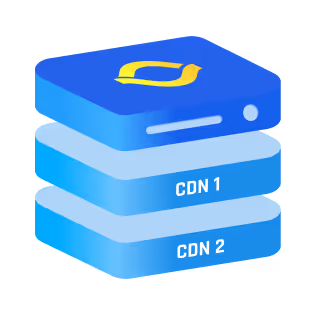CDNs are built to make the internet faster, but even they have limits. When traffic spikes or servers go down, something smarter has to kick in, that missing piece is CDN Load Balancing. It keeps your site fast, available, and efficient across the globe.
That system is CDN Load Balancing, but what does the term actually stand for? And how does it help you supercharge your website to success? Let’s talk about this and more, in the article below:
What is CDN Load Balancing?
In the bustling lanes of the internet Content Delivery Networks (CDNs) play a critical role. They’re the heart and soul, ensuring data gets to its destination fast and efficiently, contributing to a seamless online experience.
Now, imagine a scenario where you have multiple networks of servers (i.e, multiple CDNs) that can share the burden of carrying a hefty load of traffic. That’s where CDN Load Balancing steps in.
To put it simply, CDN Load Balancing is a robust method employed to distribute network traffic across multiple Content Delivery Networks.
{{cool-component}}
How does CDN Load Balancing Work?
Aptly named, CDN Load Balancing works by balancing the “load” or the number of end users across a network of CDNs.
Let’s dissect this concept step by step:
1. DNS-Based Load Balancing
This is the most popular method of CDN load balancing. Here's how it works:
Step #1: DNS Resolution
The process starts when an end user wants to access content on a website. The user's device first performs a DNS resolution to identify which CDN the request should be sent to.
Step #2: CDN Receives the Request
Upon determining the appropriate CDN via DNS, the user's device sends the request directly to the chosen CDN. The CDN then intercepts this request.
Step #3: Content Delivery
Rather than allowing the request to travel all the way to the origin server, which might be located on the other side of the world, the CDN delivers the data from a location closer to the user. This ensures content is delivered rapidly and efficiently.
2. Client-Side Based Load Balancing
This method doesn't rely on the CDN for decision-making. Instead, decisions are made on the client's side. Here are its attributes:
Advantages:
- Faster Reaction to Rebalance: Changes in traffic distribution can be addressed more swiftly.
- Better Granularity of Traffic Split: Offers a more refined control over how traffic is distributed.
- Cost-Effective: Can be cheaper in the long run compared to DNS-based solutions.
Disadvantages:
- Lack of Transparency: It requires a proprietary solution on the client's side, which might not always be transparent.
- Higher Implementation Effort: It demands more effort in terms of implementation and maintenance.
How Failover Works in CDN Load Balancing?
Failover keeps your website online when part of your infrastructure fails. In CDN load balancing, it ensures traffic is automatically rerouted to healthy CDN nodes or providers.
How it works:
- Health checks run on all endpoints
- If a CDN or server fails, it's marked as unhealthy
- Traffic is instantly rerouted to working nodes or other CDNs
Benefits of CDN Load Balancing
Understanding the workings of CDN Load Balancing service inevitably leads to the realization of its several benefits. Let’s review each of them in detail:
- Enhanced Performance: By distributing traffic, CDN Load Balancing reduces the burden on individual CDNs, allowing them to perform optimally.
- Increased Reliability and Availability: In the unfortunate event that one CDN fails or is experiencing local outages, CDN Load Balancing can quickly reroute the traffic to the other active CDN.
- Cost Savings: By selecting the best combo of cost-effectiveness, and performance, organizations can reduce costs, and optimize their delivery speeds - selecting the best CDN provider for each geographical location.
Best Practices for CDN Load Balancing
Implementing CDN Load Balancing effectively requires adherence to a few best practices:
{{cool-component}}
What Is Anycast and Why It Matters in CDN Load Balancing
Anycast allows multiple servers to share one IP. Traffic is routed to the nearest available server, boosting speed and resilience.
Benefits in CDN load balancing:
- Faster response times (nearest node wins)
- Automatic traffic rerouting during failures
- Helps mitigate regional issues and DDoS attacks
Anycast supports DNS CDN load balancing by making DNS resolution fast and fault-tolerant.
Anycast vs Unicast
So, which model is better for CDN reliability?
Anycast is a core feature in resilient CDN load balancing setups, while Unicast is better for predictable, one-to-one routing.
Global Load Balancing vs Local Load Balancing
CDN Load Balancing comes in two main flavors, global and local. Each serves a different purpose in optimizing traffic flow across the network.
Global Load Balancing
GSLB method distributes users to the best available region or data center, often using DNS-based decision-making or geo-aware routing. It ensures:
- Minimal latency for international users
- Load distribution across continents or regions
- Redundancy in case an entire region becomes unavailable
In multi CDN load balancing environments, global routing may direct a user to a specific CDN provider based on region or performance metrics.
Local Load Balancing
Once a user has been routed to a region (or CDN), local load balancing takes over to distribute traffic across individual edge servers or POPs (Points of Presence). This is crucial for:
- Preventing overload of a single node
- Optimizing last-mile delivery performance
- Handling micro-failures inside a single CDN region
Using both in tandem, global to direct where a request goes, and local to control how it’s processed, provides a scalable, resilient architecture that enhances content delivery around the world.
Conclusion
In conclusion CDN Load Balancing ensures your CDN keeps up and running, even when one of them is down. In the fast-paced, ever-evolving internet landscape, the efficiency, reliability, and performance offered by CDN Load Balancing are not just valuable – they’re essential!
FAQs
1. What are the different methods of CDN load balancing?
The most common methods include DNS-based, client-side, and Anycast routing. Each method determines how user requests are distributed across CDNs or servers, helping balance load, reduce latency, and prevent outages.
2. How can businesses choose the right CDN load balancing solution?
Choosing the right method depends on scale, performance needs, and budget. DNS CDN load balancing is simple to set up, while multi CDN load balancing using Anycast provides better global performance and failover reliability.
3. How does load balancing enhance redundancy in a CDN?
CDN load balancing adds redundancy by ensuring that if one server or CDN fails, another can instantly take over. This failover capability minimizes downtime, enhances user experience, and protects against traffic spikes or outages.



.png)
.png)
.png)






